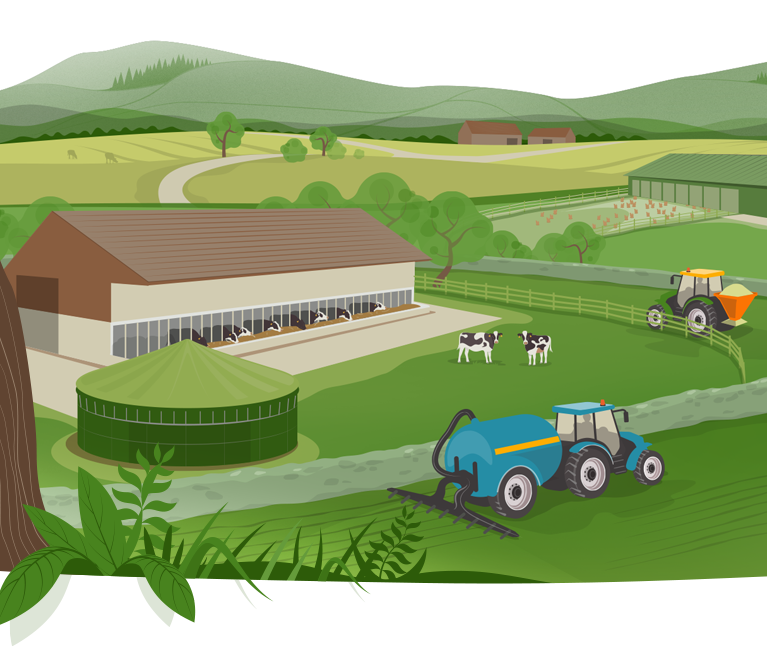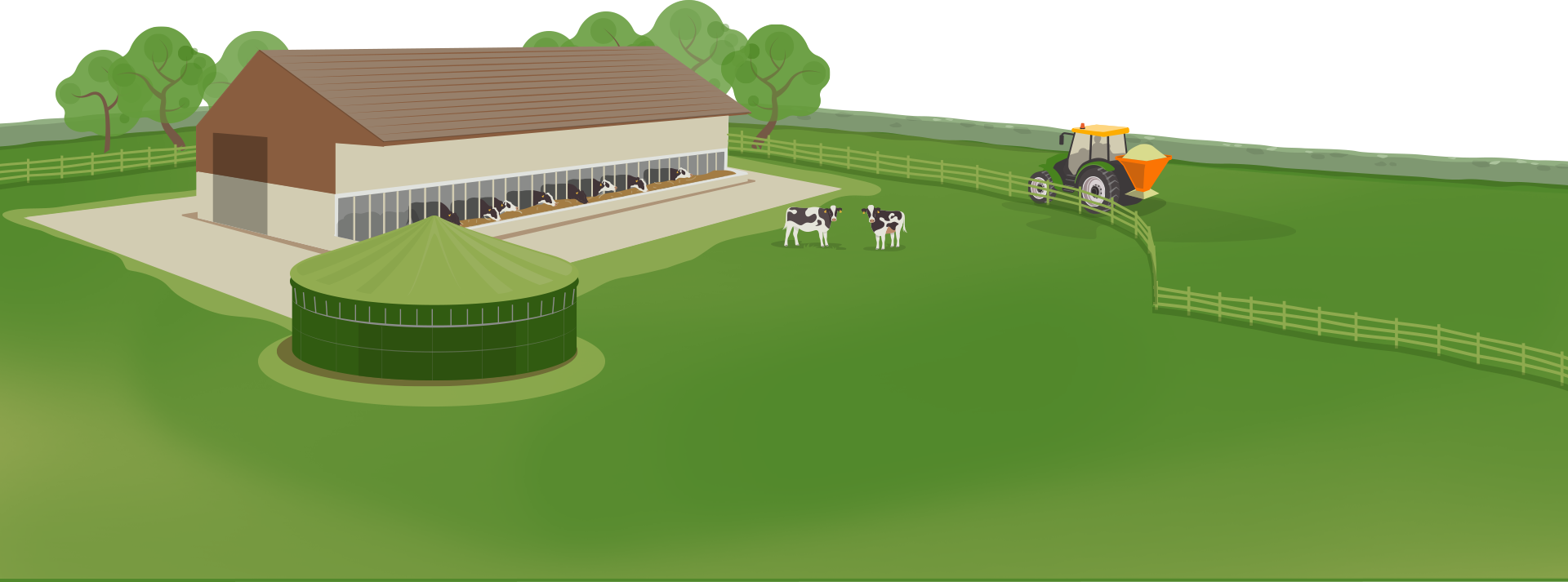Improving Air Quality
Poor air quality is one of the biggest risks to the environment and to public health. The Welsh Government’s Clean Air Plan sets out a range of actions to be taken to improve the nation’s air quality. For farming, the focus is on ammonia because it contributes around 85% of Welsh ammonia emissions. The majority of agricultural ammonia emissions are from livestock farming (mainly cattle).
Nitrogen is lost to the air as ammonia from manures and from spreading fertiliser. It builds up in the atmosphere and then falls on to the land, interfering with ecosystems and making it impossible for some species to survive. In low concentrations, ammonia is not harmful to human health. However, it can react with other pollutants to make Particulate Matter, which can get deep into lungs causing health problems for people. Ammonia lost to the air is also nitrogen lost for plant growth, costing farms money.
This tool has been developed to show the actions a typical Welsh farm may be able to take to improve air quality. These actions also bring real business benefits. As well as from fertiliser use, ammonia can be lost whenever slurry or muck is exposed to the air. Because of this, the actions need to be used together to get the full benefits. To learn more about how you could carry these out on your own farm, follow the links at the bottom of each example. This will show you what support is offered by Farming Connect, the Welsh Government and others. Guidance on lowering ammonia emissions is also available in the Code of Good Agricultural Practice.
Please remember that slurry gases can kill. For more information on managing the risks from slurry please read the Health and Safety Executive guidance.
Use our interactive farm to discover ways to improve air quality. Click on the hotspots to learn more




Improving Air Quality
Air treatment and muck drying
Exhaust air from pig and poultry houses can be treated by acid scrubbers or biotrickling filters to remove the ammonia. These systems are fitted to the outlets of mechanically ventilated housing and are very effective where the animals are kept indoors all the time, with some reducing ammonia emissions in the exhaust air by up to 90%. The technology is widely used in new housing and can also be retrofitted to older buildings.
It is also important to keep poultry muck and litter dry because, when it becomes wet, much more ammonia is lost to the atmosphere. It can be kept dry by using a belt drying system. This lowers ammonia emissions by 30%. The muck should be stored under a water-proof cover.
Other benefits
- They also have the benefit of reducing smells, which is important if it’s near where people live
- Drier poultry muck will have a higher fertiliser value
Support
Farming Connect could help you improve the efficiency and sustainability of your business. Discover how Farming Connect can assist you with improving skills, accessing advice and be inspired by new and innovative ideas from the demonstration network and the Knowledge Exchange Hub.


Improving Air Quality
Efficient use of protein in the diet
All animals eat nitrogen through the protein in their feed. More than half of the protein animals take in through their food is lost as nitrogen in their muck. These losses can be lowered by matching (as closely as possible) the protein content of the animal’s diet to its needs. This simple change can lower ammonia emissions by around 10%.
Research1 has found that dietary crude protein levels for lactating dairy cows can be lowered to 14% with little to no loss in milk yield or fertility. A project at the Institute of Biological, Environmental & Rural Sciences (IBERS) has also found no overall effect on growth from lowering crude protein, from about 14% to about 11.5%, in heifer diets. This has a big benefit in managing ammonia emissions on the farm because the losses at other stages (at housing, storage and spreading) becomes much less but it is important to speak to your nutritionist before making any big changes to cow diets.
Other benefits
- Well-balanced, lower protein rations mean lower input costs
- It can also potentially improve fertility (more studies are being carried out)
Support
Farming Connect could help you improve the efficiency and sustainability of your business. Discover how Farming Connect can assist you with improving skills, accessing advice and be inspired by new and innovative ideas from the demonstration network and the Knowledge Exchange Hub.
-
Farming Connect offers advice on formulating well-balanced rations for cattle at different growth stages.Advice
-
This Technical Article has more information on the importance of protein in the dairy cow diet.Technical article
-
This Technical Article explores how to improve dietary nitrogen use in dairy cattle.Technical article
-
Sampling, testing and one-to-one advice from local vets is available through Animal Health Clinics for farm businesses registered with Farming Connect.Clinics

Improving Air Quality
Extending the grazing season
When cattle are grazing they produce much less ammonia emissions because their urine is quickly absorbed in to the ground. By extending grazing in to the autumn and spring, less slurry is produced by the animals when they are housed over winter. With grass being the cheapest feed for producing milk, this approach can help cut costs. However, extending grazing in the autumn and spring needs to be carefully managed to avoid soil compaction and damage to the sward, which can lead to water pollution.
With more grass grown, rotational grazing can extend the grazing season but it may not be suitable for all farms. It needs careful planning and good grassland management. This needs to take into account the farm’s soil type, topography and infrastructure and needs to be flexible to adapt to changes in the weather. Multi-species leys can help because they have a longer growing season and offer other benefits like lowering the need to buy in fertiliser.
Other benefits
- Producing more milk from forage lowers costs
- AHDB estimates £1.25 a cow a day can be saved by cattle being at grass rather than being housed
- The deeper roots of multi species leys means they improve soil structure and grow for longer in dry periods
Support
Farming Connect could help you improve the efficiency and sustainability of your business. Discover how Farming Connect can assist you with improving skills, accessing advice and be inspired by new and innovative ideas from the demonstration network and the Knowledge Exchange Hub.
-
The Welsh Pasture Project offers useful information to help you make proactive grazing management decisions.Welsh Pasture Project
-
Prosper from Pasture is a short training programme, with three levels, that will help you develop your knowledge and confidence in grassland management.Prosper from Pasture
-
Farming Connect offers advice on planning grazing to make the most of grass.Technical article
-
Farming Connect offers advice on preparing a winter-feed budget.Technical article
-
At Mountjoy Farm, a Farming Connect Demonstration Farm, William Hannah has invested in infrastructure to extend the grazing season.Demonstration network
-
This Technical Article explores how to get more milk from forage.Technical article

Improving Air Quality
Regular scraping
The sooner slurry reaches the store from livestock areas the less it is exposed to air, with 15% less ammonia lost at housing. Cubicle and feed passages should be designed to drain quickly and be scraped as frequently as possible. To get the slurry to the store as soon as possible, it needs to be scraped from the cow cubicle house, ideally at least once every two hours. More frequent scraping means slurry has less chance to build up and cause problems with lameness.
Although it is a relatively new concept in the UK, it is possible to design cubicle houses to lower ammonia emissions by keeping any contact between muck and urine to a minimum. This involves either a sloped floor with a gutter for urine or a grooved floor with specially designed ‘toothed’ automatic scrapers. Both allow urine to drain away quickly.
Other benefits
- Clean and dry floors will improve foot health
- Specially designed grooved floors lower emissions, give good grip and help create a dry, clean environment for the cows
Support
Farming Connect could help you improve the efficiency and sustainability of your business. Discover how Farming Connect can assist you with improving skills, accessing advice and be inspired by new and innovative ideas from the demonstration network and the Knowledge Exchange Hub.

Improving Air Quality
Washing the collection yard
Concrete yards and passages contaminated with slurry emit ammonia. Collecting yards, livestock handling areas and parlours should be scraped and washed down as soon as possible after use. By washing these areas straight after milking has finished, the amount of ammonia lost can be lowered by around 70%. This may not be practical on every farm but it is a simple and relatively inexpensive way of lowering emissions. It needs be part of a dirty / clean water management system and could need extra storage for slurry or dirty water.
Other benefits
- Clean and dry floors will improve foot health
Support
Farming Connect could help you improve the efficiency and sustainability of your business. Discover how Farming Connect can assist you with improving skills, accessing advice and be inspired by new and innovative ideas from the demonstration network and the Knowledge Exchange Hub.

Improving Air Quality
Covering the slurry store
Putting a cover on a slurry store or lagoon can have a big impact by stopping ammonia escaping to the atmosphere. Watertight covers also have the benefit of stopping rain getting in to the store. Most covers include vents, which stop a build-up of methane, and also need to allow access for the slurry to be stirred.
There are three main types of covers. A tight lid, roof or a tent-type structure is very effective, reducing ammonia emissions at storage by about 80%. Floating sheets are also available and are probably the best option for smaller earth-banked lagoons. They are quite effective, reducing ammonia emissions at storage by around 50%. Slurry bags are a relatively new technology but have been widely used in the Netherlands for 30 years and are very effective, reducing ammonia emissions at storage by around 95%. If you are thinking of installing a bag, you can find out what the planning requirements are by contacting your local planning authority.
Other benefits
- Less rainwater entering the store lowers the overall amount of storage needed as well as lowering the costs of spreading
- Less Nitrogen is lost from the slurry, increasing its fertiliser value
- Less smell
Support
Farming Connect could help you improve the efficiency and sustainability of your business. Discover how Farming Connect can assist you with improving skills, accessing advice and be inspired by new and innovative ideas from the demonstration network and the Knowledge Exchange Hub.
-
The Farm Business Grant offers a financial contribution towards investment in covers or floating covers for slurry stores.Grant
-
The Sustainable Production Grant offers a financial contribution towards investment in covers or floating covers for slurry stores.Grant
-
Farming Connect offers advice for slurry and farmyard manure management and storage plans.Advice
-
Farming Connect also offers an e-learning module on Slurry Management, which addresses the need for silage, slurry and rainwater infrastructure management.E-learning
-
A guide on livestock manure and silage storage infrastructure can be downloaded free from the Construction Industry Research and Information Association.Guide

Improving Air Quality
Switching from straight urea fertiliser
Up to 45% of the nitrogen can be lost from urea-based fertilisers. Switching from urea fertiliser to nitrate (or other types of nitrogen) can lower the amount of ammonia lost by 80% for solid fertiliser. Many manufacturers also now supply urea fertiliser with inhibitors (known as protected urea). These delay the urea being broken down and keep the nitrogen in the soil for longer. This stops some of the losses seen in straight urea fertiliser but is still not as effective as nitrate fertiliser is. Although it costs more per kg than straight urea, it can lead to costs savings because less nitrogen is lost as ammonia.
Whichever fertiliser you use, by using a nutrient management plan you can make sure you meet the needs of soil and crop and minimise nutrients lost to the air or water. Spreading bagged fertiliser when the weather and ground conditions are right and using a regularly maintained, calibrated spreader gets the best results. Lowering the need to buy in fertiliser by making use of legumes (like clover) will also improve air quality, save the farm money and lower your carbon footprint.
Other benefits
- Less nitrogen is lost and so more is available to the crop
- Protected urea has a lower carbon footprint than ammonium nitrate
- A simple soil test and nutrient management planning can boost yields and save money
Support
Farming Connect could help you improve the efficiency and sustainability of your business. Discover how Farming Connect can assist you with improving skills, accessing advice and be inspired by new and innovative ideas from the demonstration network and the Knowledge Exchange Hub.
-
A project at Rhiwaedog Farm, a Farming Connect Demonstration Site, is using protected urea to look at nitrogen recovery compared to straight urea and ammonium nitrate.Demonstration network
-
Farming Connect offers subsidised support for soil testing and Nutrient Management Planning.Advice
-
The AHDB Nutrient Management Guide (RB209) offers best practice guidance on the application of mineral fertilisers, manures and slurries.More information

Improving Air Quality
Woodlands
Trees and woodlands have the potential to recapture ammonia from animal housing, slurry stores and roaming areas, lowering emissions by 20%. Tree shelterbelts should be downwind (which is ordinarily to the northwest) from the livestock housing or slurry store and need to include a short, dense backstop. The shelterbelt needs to be as wide, or wider, than the building. Trees could also be planted upwind from a slurry store to lower the wind speed over its surface. It is important to get advice before planting to make sure the right trees are placed in right location to get the most benefits.
Other benefits
- Lowers the farm’s carbon footprint
- Shade and shelter for animals
- Can soften the look of buildings to minimise the impact on the landscape
- Offer habitats to wildlife
Support
Farming Connect could help you improve the efficiency and sustainability of your business. Discover how Farming Connect can assist you with improving skills, accessing advice and be inspired by new and innovative ideas from the demonstration network and the Knowledge Exchange Hub.
-
Glastir Woodland Creation offers grants to landowners to create new woodlands.Grant
-
The Centre for Ecology and Hydrology, and Forest Research Agency has produced a calculator to get the most benefits from planting tree shelterbelts for recapturing ammonia.Calculator
-
The Centre for Ecology and Hydrology, and Forest Research Agency has produced guidance to get the most benefits from planting tree shelterbelts for recapturing ammonia.More information
-
Listen to this webinar with Farming Connect to hear about the economic and environment benefits of tree planting and establishing woodland on the farm.Webinar
-
This Farming Connect Technical Article has more information on using agroforestry to improve farm productivity and reduce environmental impact.Technical article
-
Farming Connect also offers an e-learning module on the Benefits of Trees on Upland Farms.E-learning


Improving Air Quality
Precision slurry spreading
Up to 80% of the nitrogen in slurry can be lost when using a splash plate. Using shallow injection, trailing shoe or a dribble bar equipment lowers the amount of ammonia lost by placing the slurry directly on or in the soil.
Trailing hoses (dribble bar) and trailing shoes place the slurry / digestate just above (hose) or straight on to (shoe) the soil. Slurry and digestate can also be placed in to the soil using shallow or deep injection (also known as open or closed slots). Closed slot injection is the most effective, lowering emissions by 90% but can also be the most challenging in terms of practicality. Trailing hose or shoe are quicker and cheaper than injection but less effective at lowering ammonia emissions (30-60%).
Whatever the type of precision spreading used, by using a nutrient management plan you can make sure you meet the needs of soil and crop and minimise nutrients lost to the air or water. You can also keep these loses to a minimum by avoiding spreading when the ground is covered in frost or snow and when it’s windy or raining heavily.
Other benefits
- Work in Ireland1 has shown the value of nitrogen gained can be as high as £12/ha more using a trailing shoe and £19/ha more using open slot injection compared to using a splash plate
- Precision spreaders spread the slurry more evenly and are not affected by the wind
- Precision spreading creates less aerosols, which means there is less risk of spreading bovine TB2
- There is less smell
Support
Farming Connect could help you improve the efficiency and sustainability of your business. Discover how Farming Connect can assist you with improving skills, accessing advice and be inspired by new and innovative ideas from the demonstration network and the Knowledge Exchange Hub.
-
The Farm Business Grant offers a financial contribution towards investment in shallow slurry injection systems, slurry dribble bar and trailing shoe slurry spreader.Grant
-
Farming Connect offers subsidised support for Nutrient Management Planning.Advice
-
The Safe Use and Application of Slurry is a one day training course on the best use slurry and farm yard manure.Training course
-
Master Soils is a two day workshop on improving your soil management which covers how slurry is applied influences its effectiveness and environmental impact.Workshop



Improving Air Quality
Poor air quality is one of the biggest risks to the environment and to public health. The Welsh Government’s Clean Air Plan sets out a range of actions to be taken to improve the nation’s air quality. For farming, the focus is on ammonia because it contributes around 85% of Welsh ammonia emissions. The majority of agricultural ammonia emissions are from livestock farming (mainly cattle).
Nitrogen is lost to the air as ammonia from manures and from spreading fertiliser. It builds up in the atmosphere and then falls on to the land, interfering with ecosystems and making it impossible for some species to survive. In low concentrations, ammonia is not harmful to human health. However, it can react with other pollutants to make Particulate Matter, which can get deep into lungs causing health problems for people. Ammonia lost to the air is also nitrogen lost for plant growth, costing farms money.
This tool has been developed to show the actions a typical Welsh farm may be able to take to improve air quality. These actions also bring real business benefits. As well as from fertiliser use, ammonia can be lost whenever slurry or muck is exposed to the air. Because of this, the actions need to be used together to get the full benefits. To learn more about how you could carry these out on your own farm, follow the links at the bottom of each example. This will show you what support is offered by Farming Connect, the Welsh Government and others. Guidance on lowering ammonia emissions is also available in the Code of Good Agricultural Practice.
Please remember that slurry gases can kill. For more information on managing the risks from slurry please read the Health and Safety Executive guidance.